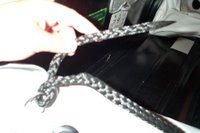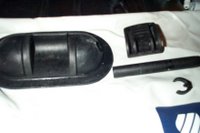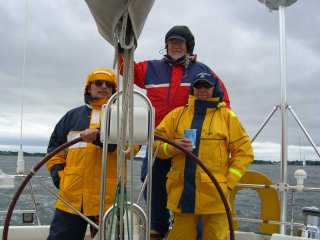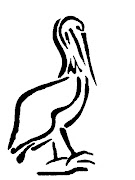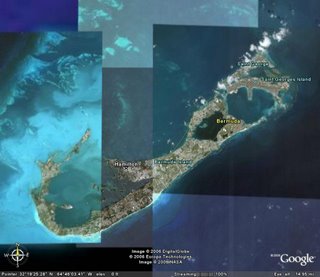
This is going to be a big post. It's all about adventure and the high seas and exotic locals and the stuff of dreams, at least for cruising sailors. Ok, maybe not all that. But some surely.
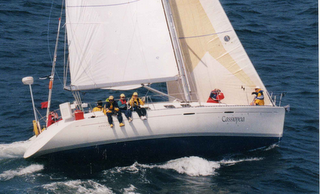 I've just finished a delivery trip from Bermuda on Laura's boat, Cassiopeia, a Beneteau 42 7, pictured here. She's pretty fast, light and nimble. She had just finished the Newport-Bermuda Race ( http://www.bermudarace.com ) where she got the first ever combined Marion-Bermuda Newport Bermuda award for her class. Read all about it at the bermudarace link. But of course, she needs to get back, too, for all her summer fun on the Long Island Sound.
I've just finished a delivery trip from Bermuda on Laura's boat, Cassiopeia, a Beneteau 42 7, pictured here. She's pretty fast, light and nimble. She had just finished the Newport-Bermuda Race ( http://www.bermudarace.com ) where she got the first ever combined Marion-Bermuda Newport Bermuda award for her class. Read all about it at the bermudarace link. But of course, she needs to get back, too, for all her summer fun on the Long Island Sound.Anyway, Laura invited me to crew her back. I've wanted to try offshore sailing for some time, longer than a coastal travel to Norfolk. This seemed like an excellent chance. So I flew Jet Blue's new route to Bermuda for $149.00 one way. It may be more now. But here's the thing: If you're going somewhere and Jet Blue flies there, take them. They are the best. Fast, friendly, efficient, and really comfortable. If you have any doubts any business can be so well run and so customer oriented, let me dispell them right now. They're great!
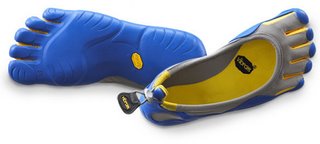 Before I go on, there's one more plug: Vibramfivefingers. They say it's like walking barefoot. They're correct - they're on the pricey side at $70.00 per pair, but if you need surefooted walking on a boat deck these are the shoes. They're like gloves for your feet. I only have two complaints - they don't breathe very well and they are a little hard to get on right in the dark. But you can literally wear them for days at a time - they dry pretty quickly and they're really comfortable. They're surprisingly protective of toes, too. All the advantages of bare feet with the protection of boat shoes. Highly recommended.
Before I go on, there's one more plug: Vibramfivefingers. They say it's like walking barefoot. They're correct - they're on the pricey side at $70.00 per pair, but if you need surefooted walking on a boat deck these are the shoes. They're like gloves for your feet. I only have two complaints - they don't breathe very well and they are a little hard to get on right in the dark. But you can literally wear them for days at a time - they dry pretty quickly and they're really comfortable. They're surprisingly protective of toes, too. All the advantages of bare feet with the protection of boat shoes. Highly recommended.
 Ok, back to Bermuda. I arrived June 23. Julie, one of our crew, was on the same flight. We checked in to Customs and Immigration together. If you're going to bring a boat back from Bermuda, there's a $21.00 exit fee you must pay when you go through customs. It was a breeze to get through. Four of us shared a really expensive cab trip to Hamilton where the Royal Bermuda Yacht Club is. The club is spectacular and with all the racing boats decked out, it was amazing to look at.
Ok, back to Bermuda. I arrived June 23. Julie, one of our crew, was on the same flight. We checked in to Customs and Immigration together. If you're going to bring a boat back from Bermuda, there's a $21.00 exit fee you must pay when you go through customs. It was a breeze to get through. Four of us shared a really expensive cab trip to Hamilton where the Royal Bermuda Yacht Club is. The club is spectacular and with all the racing boats decked out, it was amazing to look at. Well, it was party time there. The club is one of the hosts for the Newport-Bermuda race and they put on a bash that is not to be believed. But when Julie and I got to the boat I met John and the captain for the delivery, Trevor, we found the boat in need of some work and wanted some provisions. Trevor, at left, and Julie went to town to gather up some stuff to eat for the trip back. John, who raced Cassie down, went to the party, and I started to put slides back on the old mainsail so we could use it. Laura didn't want us using her new racing sails.
Well, it was party time there. The club is one of the hosts for the Newport-Bermuda race and they put on a bash that is not to be believed. But when Julie and I got to the boat I met John and the captain for the delivery, Trevor, we found the boat in need of some work and wanted some provisions. Trevor, at left, and Julie went to town to gather up some stuff to eat for the trip back. John, who raced Cassie down, went to the party, and I started to put slides back on the old mainsail so we could use it. Laura didn't want us using her new racing sails.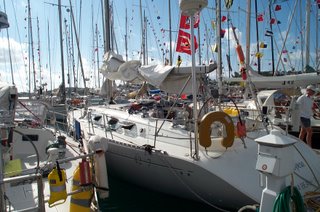 We worked on Cassie getting her ready until about 9 pm and then went to town for a good night dinner. It was nice, but really expensive. Bermuda is sweet, but expensive - everything. The next morning I was going to get a bacon and egg sandwich, but it was like $10.00 - and Bermudian dollars are not significantly different from US dollars. Anyway we decided we needed fishing gear for the trip back so we could get our meals from the sea - and I scoured Hamilton until I found a little store behind City Hall that sold diving and fishing gear.
We worked on Cassie getting her ready until about 9 pm and then went to town for a good night dinner. It was nice, but really expensive. Bermuda is sweet, but expensive - everything. The next morning I was going to get a bacon and egg sandwich, but it was like $10.00 - and Bermudian dollars are not significantly different from US dollars. Anyway we decided we needed fishing gear for the trip back so we could get our meals from the sea - and I scoured Hamilton until I found a little store behind City Hall that sold diving and fishing gear.Well, I'm no fisherman and apparently neither was anyone else on the crew, so you can imagine the proprietor's amusement when I told him I needed some line, hooks, and lure to catch some fish on the way home. He was very helpful in choosing 85lb line, and some #9 hooks, and a couple of lures. I told him what we were going to do he didn't laugh out loud. Very kind. Anyway after acquiring the stuff, it was back to the boat. Cassie was all watered up and Trevor was checking us out of Bermuda Customs and Immigration.
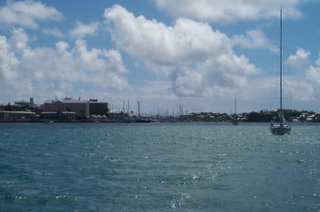
 Then it was time to go. First we had to motor over to St. Georges for fuel. It's about an hour's ride and we were checking out Cassie to make sure all the systems were running ok. We took the opportunity to bend on the cruising jib and all get to know each other a little more. Bermuda is beautiful and I really didn't want to leave. You have to see it to believe it. Navigation, however, is very, very important. The charts of the area are pretty good, and you absolutely have to obey them. Unless, of course, you have or want a shallow draft boat. Stay in the marked channels. It's a volcanic island. There's not a hell of a lot of sand outside channels but there's a lot of rock.
Then it was time to go. First we had to motor over to St. Georges for fuel. It's about an hour's ride and we were checking out Cassie to make sure all the systems were running ok. We took the opportunity to bend on the cruising jib and all get to know each other a little more. Bermuda is beautiful and I really didn't want to leave. You have to see it to believe it. Navigation, however, is very, very important. The charts of the area are pretty good, and you absolutely have to obey them. Unless, of course, you have or want a shallow draft boat. Stay in the marked channels. It's a volcanic island. There's not a hell of a lot of sand outside channels but there's a lot of rock.St. George is a tiny little harbor on the northeast side of Bermuda with a 150' cut through rock that gets you in there. It's well marked but until you're lined up on the channel, it doesn't look as if there's a place to go. Well worth the visit and it's a great place to get fuel. Sorry I don't have any pictures.
We left St. George under power while we got some navigation done - we wanted to be sure we were clear of the rocks, coral, and what have you before we turned northwest for home. Although the way is well marked, if you don't understand that the marks are spindly little towers, you might not know that's what they were. There were about five or ten boats leaving with us and that night we could see their nav lights while we all sailed for home. We had set the spinnaker in the late afternoon and were cruising along in light swell at 7 to 8 knots.
Julie and Trevor's provisioning was well put to use the first night - Julie, even though feeling a bit under the weather, still managed a great first night's meal with chicken and rice. Trevor had assigned three hour watches for the trip, with me taking 6 - 9, Julie, 9-12, John, 12 - 3, and Trevor from 3 - 6. I happened to like my shift. Not sure about anyone else, though.
The water around Bermuda is a deep turquois and around 85 degrees F. For the first night and next day we were just getting acclimated to each other and the boat. Cassie was spectacular - on a broad reach in 15 to 20 knots (true) wind she just flew! Although the auto pilot, 'Ray', handled the steering most of the time, John usually spent his watches hand steering for "something to do".
Well, of course, we couldn't sail the exact rhumb line to Ambrose, so every twelve hours or so we had to jibe. With the cruising spinnaker it was just easier to take the sock down, move the whole mess around the headstay, and reset the thing.
After the second day out (Monday), we took down the spinnaker and reset the jib. The wind was steady at 20 knots and gusting higher, and the seas were building to 8 - 10 feet. Cassie was still plowing along at 7 to 9 knots.
Tuesday we slowed down to 6 to 7 knots - mostly because the wind was a little less, but since the weather fax indicated an area of low pressure to move across our path we decided not to reset the spinnaker. Also, there was significant wear on the spin halyard and we didn't want to risk losing the halyard down the mast. It's a pain to re-reeve.
This seemed like a good time to troll for dinner. So with John's help I attached weights and the lure to a spool of 89 lb test line, and set about 200 yards out. Now, I've never fished. I've always felt that it's easier to hunt at the supermarket than in the great outdoors. So far, I've been pretty successful at that endeavor. The other crew were nearly as clueless. Anyway, having learned that alcohol in the gills will kill fish right away, I had a bottle of rum handy on deck. The line ran through the stern rail over the transom and out.
 After about 20 minutes Trevor mentioned very calmly that I have a fish on the line - and sure enough, the line was tight - cool! We wanted to get Julie and John up to see the 'old man of the sea' get his fish. Well, they were totally out to the world - so, no pictures. I was too busy reeling the fish in. It was a wahoo, about 15 to 20 lbs, perhaps 18 - 24" long. I know you're thinking, "Yeah sure - it was thiiiiis big!" Really.
After about 20 minutes Trevor mentioned very calmly that I have a fish on the line - and sure enough, the line was tight - cool! We wanted to get Julie and John up to see the 'old man of the sea' get his fish. Well, they were totally out to the world - so, no pictures. I was too busy reeling the fish in. It was a wahoo, about 15 to 20 lbs, perhaps 18 - 24" long. I know you're thinking, "Yeah sure - it was thiiiiis big!" Really.However, there wasn't any plan to get it aboard. We didn't want to club it to death in the cockpit because that's just too messy, and you'll notice that a wahoo is a pretty evil looking fish - it's called an 'ocean barracuda'. To Trevor and I it looked big enough to hurt us. So, dragging this fish along at the transom, it's looking up at me like it's saying, "Ok, you stupid bastard, what now? You caught me. Here I am ready to die for you, and you can't even get me aboard!" and with that leapt of the hook.
Right, well, new plan - Cassiopeia has an opening transom that has a swim platform. Trevor and I decided to use it as a fish well. Open it up partially, drop the fish in, close the thing, wait for the fish to die.
We set the line out again but to no avail - the wind was rising for the evening and we were going too fast for trolling. Since I was on watch at nightfall, I got to see the stars come out - Julie came up a little early for her watch and taught me about Scorpio, and Antares - the heart of Scorpio - also, about the Summer Triangle formed by Vega, Altair, and Deneb. She pointed out how to find Cassiopeia, and the two main stars of Orion, Rigel (lower right) and Betelgeuse (upper left).
 The next day we were cruising along at 6 to 7 knots again so out went the line. We were approaching the Gulf Stream and the water was getting warmer. It only took about half an hour this time to hook a fish, and this time the whole crew was awake for the spectacle! John and Julie took up the photo journalist positions while I dragged the fish to the boat - there wasn't much fight until the sucker was right near the boat, and then it was pretty exciting!
The next day we were cruising along at 6 to 7 knots again so out went the line. We were approaching the Gulf Stream and the water was getting warmer. It only took about half an hour this time to hook a fish, and this time the whole crew was awake for the spectacle! John and Julie took up the photo journalist positions while I dragged the fish to the boat - there wasn't much fight until the sucker was right near the boat, and then it was pretty exciting!Trevor got the transom opened, and I finally dragged the fish into it - then Trevor closed it, and there you have it - one fish captured! We all thought this was some kind of tuna, and weighed approximately 10 -12 lbs. Anyway, John took the time to teach me how to gut a fish using a cutting board on the fully open transom. Then when it was all cleaned, I cut it into 6 big steaks and two pretty big filets. It tasted like tuna, but I can't find any pictures that match it.
That evening, Julie cooked up a spectacular meal of what we'll call fresh tuna and tomatoes and avacado and black beans and salsa with fresh lime. It was amazing. A team effort, and of course, eating the thing you killed yourself is always appealing. Frankly, after all the effort, I still can't see the pleasure in fishing for fun. For food, yes, but just to show you're smarter than the fish?
Anyway, as night fell and the stars came out, the wind and the seas picked up - they were running 8-10 feet, wind gusting over 25 knots. As we were getting closer to the Gulf Stream, the seas continued to pile up. But Cassiopeia was screaming along on a broad reach behaving like a lady!
Here's something: You have not seen stars like a night at sea with no moon. You may think you have. You may have even seen the sky from Montana, the Big Sky State. But it's nothing compared to this. On a clear night like ours were the Milky Way is so bright it looks like a cloud that spans the sky - there are so many stars! We just don't get to see them like that anywhere near the coast of any country. The light pollution just overwhelms most of the stars. Even after my watch I had to stay up and just gaze at them. Julie is a fount of knowledge about these things - so I got to learn alot, too. But just staring at them. If it wasn't for the fact that I was really really tired I'd have gotten the binocs and gotten comfortable on deck and just looked around.
There were some rain showers during the night - or so I hear. But the next morning we were into the gale - the seas had grown to 15 feet or so and the wind had been over 35 knots for more than a few minutes. But it soon settled down to 25 to 30 and once again, Cassie was a lady - we were hitting 10 and 11 knots regularly, with speed normally 8 or 9 knots. John saw the record for the trip - 12.6 knots. I only got to 12.4. Oh, well.
Now there's a big difference between a gale in sunny weather and a gale in crappy weather, at least psychologically. In the sun, it's an exciting sail. In crappy weather, it's frightening. Same wind, same sea state. Also, we were so very glad we weren't headed towards Bermuda - that would have sucked bigtime!
I was told the Gulf Stream would be noticible - Except for wave trains in two different directions, I couldn't see it. The water was much warmer than outside it, but it didn't smell different, or look different. It might just have been this time. Who knows?
Here's a tidbit of knowledge - Big ships are required to monitor channel 16 on the VHF. This is a good thing, and you should, if you're offshore, keep your VHF on 16 as well. Here's why: In the middle of the worst of the blow, we noticed a large tanker in what could very well have been a collision course with us about a mile or two away. Well, naturally we're supposed to give way but that would have meant heading up into the big waves or jibeing in really rough seas.
So, Trevor told me to contact the ship - I hailed it with "Red tanker near latitude xx yy.zzz north, longitude xxx yy.zzz west, this is the sailing vessel Cassiopeia" and repeated it two more times. Suddenly a voice responded, "This is the big red tanker near you Cassiopeia." So on it went - we talked and I asked if they could see us. They indicated they hadn't but now that we pointed it out, sure. I asked if they thought they were on an intercept course, and they allowed they might be. I asked if they could alter course a few degrees until we passed. They asked me to wait a bit. About three or four minutes later they indicated they'd change course and pass astern of us.
How cool is that?
Here's another thing: In fog, this also works. If you don't have radar and you're in a channel or approaching one, it doesn't hurt to broadcast a 'securite' on channel 16 giving your position, speed and course every few minutes. This gives big ships an indication of who and where you are. Powerboats are another story as they probably don't listen.
 For the first three days it was brutally sunny - Trevor said after the first day the he wasn't sitting in the sun all day and promptly rigged up his sleeping bag as a sunshade. This resulted at first in great hilarity, and later watch standing in the shade. Every day we had to ask Trevor for his sleeping bag to rig. This worked perfectly! The sun was always from the appropriate direction because of our direction of travel.
For the first three days it was brutally sunny - Trevor said after the first day the he wasn't sitting in the sun all day and promptly rigged up his sleeping bag as a sunshade. This resulted at first in great hilarity, and later watch standing in the shade. Every day we had to ask Trevor for his sleeping bag to rig. This worked perfectly! The sun was always from the appropriate direction because of our direction of travel.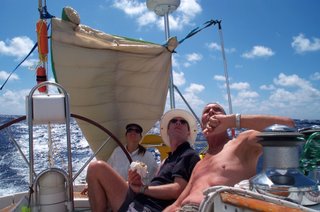 When we left Bermuda, we noticed the radar reflector on the mast was, um, cockeyed. Really, it looked like it took a pretty hard knock, but it seemed ok. Sometime during the second night which was a little rough, one of the sides of the mounting broke and when I got on my watch I noticed that the thing was flopping around. So in this accompanying picture there is some discussion going on about what to do about the whole thing.
When we left Bermuda, we noticed the radar reflector on the mast was, um, cockeyed. Really, it looked like it took a pretty hard knock, but it seemed ok. Sometime during the second night which was a little rough, one of the sides of the mounting broke and when I got on my watch I noticed that the thing was flopping around. So in this accompanying picture there is some discussion going on about what to do about the whole thing.Sometimes, it's really good to be the heaviest person onboard. It means you're the last candidate to go up the mast. Conversely, it's not so good to be the lightest. Well John volunteered to go up and take the thing down before we lost it. Mission accomplished. Saved the reflector for the fog coming into New York harbor.
Well, when I went to sleep the fourth night out fog had started to come up - we had come through the Gulf Stream, and the water temperature had gone down into the 70's and it was becoming pretty cool. Since it was the last night, Trevor had us on doubled up watches to pay attention to the traffic coming in towards Ambrose light. Because of the now very dense fog, three were on watch - one to monitor the radar and two topsides to watch and listen for boats.
Remember what I said about channel 16? Well that's what we used all night - we had radar and helped other sailboats without it know where they were and what was around them. It was tense but not scary. I mean, it was pretty much flat calm.
The wind had died mostly, so we took the sails down and motored the last 50 or miles to the Verazzano Bridge. As we came up to the narrows, the fog lifted and the sun came out. We motored by the Statue of Liberty and took a group photo which I'll post soon.
We caught the East River at the right time, and zoomed up to Stamford and to Cassie's home berth. The whole trip was about 5 days and one hour. And a lifetime of fun!
There's nothing like a great sail for a long time with good people and a good boat.
I'll be seeing you on the water, but maybe offshore water!


